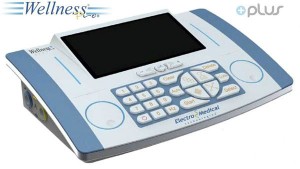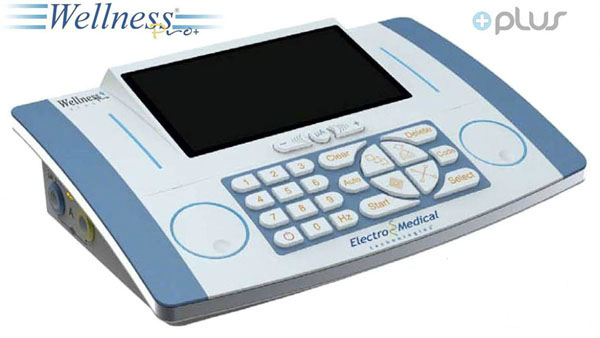What is a Wellness Pro Plus Device?
The Wellness Pro PLUS is the advanced electrotherapy device used for pain control. It is an FDA registered, laboratory tested and registered medical device. It is digitally controlled and designed for the precise treatment to be used as an adjunctive treatment of post-surgical or post-traumatic acute pain.
The Wellness Pro PLUS ® Frequency Generator is more then a TENS Unit. This is not like ANY other TENS Unit you have ever seen or experienced. The results are the PROOF that this is not like other devices.
“I can take someone using the typical TENS that is currently ineffective and no longer useful for pain relief and get immediate, improved, and amazing results in only a few minutes of treatment with the Wellness Pro PLUS”, states Kathy Strand RN, owner of the Wellness Pro PLUS. ” It is a device that you have to put on and see the amazing results. It is DIFFERENT than other TENS Units and more effective and you will know that in the first 10 minutes of treatment”.
It is an FDA cleared and laboratory tested Class II medical device with the most flexibility of use and large frequency range.
How does electrotherapy work to reduce pain?
In order to adequately explain how electrotherapy works, it is appropriate to begin by considering certain fundamental aspects of living tissue.
The body is made up of a vast number of cells. In many ways these cells act like tiny batteries, storing and releasing energy, doing their work of taking in nutrients, releasing waste products, repairing and reproducing themselves, etc. Each cell, like any battery, has a measurable electrical charge, which must be maintained in order to function properly.
Energy flows constantly between all cells throughout the electrical circuitry of the body. When various forms of damage or trauma occurs to living tissue, there is a disruption in the electrical capacity of the involved cells and after an initial surge, there occurs, a measurable decrease in the production and flow of energy through the electrical network of the involved tissues. This condition is generally accompanied by pain in the area and often results in the body’s inability to completely repair itself. Therefore, lengthy rest periods and inactivity are often prescribed in order to attain eventual restoration of normal function.
The gate control theory of pain, put forward by Ronald Melzack and Patrick Wall in 1962, and again in 1965, is the idea that the perception of physical pain is not a direct result of activation of pain receptor neurons, but instead is modulated by interaction between different neurons, both pain-transmitting and non-pain-transmitting. The theory asserts that activation of nerves that do not transmit pain signals can interfere with signals from pain fibers and inhibit an individual’s perception of pain.
In 1991, two research scientists, Dr. Erwin Neher and Dr. Bert Sackmann won the Nobel Prize in Physiology or Medicine by detecting electrical currents of a trillionth of an ampere in the membrane, on the surface of a cell.
Detailed studies are provided here.
THE NOBEL ASSEMBLY AT THE KAROLINSKA INSTITUTE
The Nobel Assembly at the Karolinska Institute has awarded the Nobel Prize in Physiology or Medicine in 1991 jointly to : Erwin Neher and Bert Sakman
Summary
Each living cell is surrounded by a membrane, which separates the world within the cell from its exterior. In this membrane there are channels, through which the cell communicates with its surroundings. These channels consist of single molecules or complexes of molecules and have the ability to allow passage of charged atoms, that is ions. The regulation of ion channels influences the life of the cell and its functions under normal and pathological conditions. The Nobel Prize in Physiology or Medicine for 1991 is awarded for the discoveries of the? function of ion channels. The two German cell physiologists Erwin Neher and Bert Sakmann have together developed a technique that allows the registration of the incredibly small electrical currents (amounting to a picoampere – 10-12A) that passes through a single ion channel.The technique is unique in that it records how a single channel molecule alters its shape and in that way controls the flow of current within a time frame of a few millionths of a second.
Neher and Sakmann conclusively established with their technique that ion channels do exist and how they function. They have demonstrated what happens during the opening or closure of an ion channel with a diameter corresponding to that of a single sodium or chloride ion. Several ion channels are regulated by a receptor localized to one part of the channel molecule which upon activation alters its shape. Neher and Sakmann have shown which parts of the molecule that constitute the “sensor” and the interior wall of the channel. They also showed how the channel regulates the passage of positively or negatively charged ions. This new knowledge and this new analytical tool has during the past ten years revolutionized modern biology, facilitated research,and contributed to the understanding of the cellular mechanisms underlying several diseases, including diabetes and cystic fibrosis.
What Happens Inside the Cell?
Inside the cell membrane there is a well-defined environment, in which many complex biochemical processes take place. The interior of the cell differs in important respects from its outside. For example, the contents of positive sodium and potassium ions and negatively charged chloride ions are quite different. This leads to a difference in electrical potential over the cell membrane, amounting to 0.03 to 0.1 volts. This is usually referred to as the membrane potential.
The cell uses the membrane potential in several ways. By rapidly opening? channels for sodium ions the membrane potential is altered radically within a thousandth of a second. Cells in the nervous system communicate with each other by means of such electrical signals of around a tenth of a volt that rapidly travel along the nerve processes. When they reach the point of contact between two cells – the synapse – they induce the release of a transmitter substance. This substance affects receptors on the target cell, often by opening ion channels. The membrane potential is hereby altered so that the cell is stimulated or inhibited. The nervous system consists of a series of networks each comprised of nerve cells connected by synapses with different functions. New memory traces in the brain are for example created by altering the number of available ion channels in the synapses of a given network.
All cells function in a similar way. In fact, life itself begins with a change in membrane potential. As the sperm merges with the egg cell at the instant of fertilization ion channels are activated. The resultant change in membrane potential prevents the access of other sperm cells. All cells – for instance nerve cells, gland cells, and blood cells – have a characteristic set? of ion channels that enable them to carry out their specific functions. The ion channels consist of single molecules or complexes of molecules, that forms the wall of the channel – or pore – that traverses the cell membrane and connects the exterior to the interior of the cell (Figure 1B and 1D). The diameter of the pore is so small that it corresponds to that of a single ion (0.5-0.6 millionths of a millimeter). An immediate change in the shape of the molecule leads to either an opening or a closure of the ion channel. This can occur upon activation of the receptor part of the molecule (Figure 1D) by a specific signal molecule. Alternatively, a specific part of the molecule that senses changes in membrane potential can open or close the ion channel.
Figure 1. Registration of the flow of current through single ion channels using the recording technique of Neher and Sakmann. A schematically shows how a glass micropipette is brought in contact with the cell, and B, using a higher magnification, a part of the cell membrane, with ion channels, in close contact with the tip of the pipette. The interior of the pipette is connected to an electronic amplifier. C shows a channel in greater magnification with its receptor facing the exterior of the cell and its ion filter. D shows the current passing through the ion channel as it opens.
Can the WellnessPro help me with my pain?
Most likely, yes. Electromedical Technologies and our partner clinics, University research centers in Europe and in the US have overseen treatments using the Wellness Pro PLUS in the reduction of pain.
 “Warranty during the first 3 years. We will send you a brand new machine!”
“Warranty during the first 3 years. We will send you a brand new machine!”
Advantages of Integrating Wellness Pro PLUS to your
Pain Management Program
- -May decreases pain which may promote return to work 1
- -Electrotherapy has no known side effects and no risk of overdosing
- -Is cost effective, typically reimbursed, and easy to administer
- –Laboratory safety tested to highest IEC standards
The Future Of Bio-Electromedicine Pain Management is here in Texas!
Finally Pain Free is the Solution to All Your Pain Needs!
The Problem:
Pain is a silent epidemic in the United States
–Over 60 Million Americans live with acute pain caused by disease, disorder or accidents
-An additional 25 million people suffer acute pain resulting from surgery or accidents
-Four out of every 10 chronic pain patients are currently not seeing a physician for pain free relief
Possible Solution: Electrotherapy
The last decade has seen a major shift in the way Americans view medicine. Despite the benefits of pharmacological treatments and surgical procedures, associated side effects and addictions have demonstrated to the medical community a need for additional approaches to patient care.
Today a huge number of patients are turning to complementary therapies like Chinese medicine, acupuncture, chiropractics, nutritional super foods, targeted physical therapy, yoga and psychology, to name a few.
Here in the United States more and more people are discovering alternatives to drug treatments and have found a very powerful and effective modality that helps you become pain free – Electromedicine!
The Bio Electrotherapy system known as the WellnessPro® PLUS is a complementary treatment modality that has been FDA cleared to market and is a safe and effective device for pain management when used as a adjunctive treatment.
Having been used in many other countries for decades, U.S. practitioners are now finding that there are many inherent advantages to Bio frequency technology.
References
- 1 Fisbain D, Chabal C,
Abbott A, et al. . Transcutaneous electrical nerve stimulation (TENS) treatment
outcome in long-term users. Clinical Journal of Pain. 1996;12;201-214. - 2 Chabal C, Fishbain D,
Weaver M, Heine L.. Long-term transcutaneous electrical nerve stimulation (TENS) use:
Impact on medical utilization and physical therapy costs. Clinical Journal of Pain. 1998;14;66-73. - 3 Erd M, Erdogan A,
Erbil N, et al. . Prospective, randomized, placebo-controlled study of the effect of
TENS on post-thoracotomy pain and pulmonary function. World J Surg. 2005;29;1563-1570. - 4 Bjordal J, Johnson M,
Ljunggreen A. . Transcutaneous electrical nerve stimulation (TENS) can reduce
postoperative analgesic consumption. A meta-analysis with assessment of optimal
treatment parameters for postoperative pain. Eur J Pain. 2003;7;181-188. - 5 Facchinetti F, Sforza
G, Amidei M, et al. . Central and peripheral beta-endorphin responses to transcutaneous
electrical nerve stimulation. NIDA Res Monograph. 1986;75;555-558

